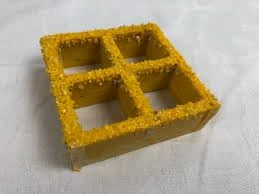loading...
- No. 9, Xingyuan South Street, Dongwaihuan Road, Zaoqiang County, Hengshui, Hebei, China
- admin@zjcomposites.com
- +86 15097380338
- Welcome to visit our website!
fiber reinforced polymer bars
The Evolution and Applications of Fiber-Reinforced Polymer Bars
Fiber-reinforced polymer (FRP) bars have emerged as a revolutionary material in construction and civil engineering, offering superior strength, durability, and resistance to environmental degradation compared to traditional materials. These composite materials, which typically consist of a polymer matrix reinforced with fibers such as glass, carbon, or aramid, are increasingly being utilized in various applications, from bridges and buildings to underground structures and rehabilitation projects.
Enhanced Characteristics of FRP Bars
One of the primary advantages of FRP bars is their high strength-to-weight ratio. This characteristic allows for reduced dead loads in construction, making them particularly useful in applications where weight is a concern. Additionally, FRP bars have excellent tensile properties, often outperforming steel reinforcement in terms of tensile strength and corrosion resistance. This is especially important in environments exposed to moisture, chloride ions, and other aggressive chemicals, as conventional steel reinforcement can suffer from corrosion, leading to structural failures and increased maintenance costs.
Another significant benefit of fiber-reinforced polymer bars is their non-magnetic and non-conductive properties. This makes them ideal for use in applications where electromagnetic interference is a concern, such as in MRI facilities or research laboratories. The electrical insulation properties of FRP also make them suitable for electrical applications or structures where electrical conduction would be detrimental.
The Evolution and Applications of Fiber-Reinforced Polymer Bars
FRP bars are predominantly used in reinforced concrete structures as an alternative to traditional steel reinforcement bars (rebar). Their lightweight nature simplifies transportation and handling, ultimately speeding up the construction process. In seismic applications, FRP bars have shown great promise due to their ability to absorb energy and withstand deformation without significant weakening. As a result, structures reinforced with FRP are often more resilient to earthquakes than those using conventional materials.
fiber reinforced polymer bars

Moreover, FRP bars are gaining popularity in the rehabilitation of existing concrete structures. As urban infrastructure ages, the need for repair and reinforcement has become critical. Incorporating FRP bars into repair systems can enhance the load-carrying capacity of aging structures while minimizing additional weight. The ease of installation and the ability to bond with existing materials further streamline refurbishment projects.
In addition to structural applications, FRP bars are being utilized in various civil engineering projects, such as tunnels and retaining walls. Their resistance to environmental factors, such as moisture and chemical attack, contributes significantly to the longevity and durability of these structures, reducing the frequency of repairs and maintenance.
Challenges and Future Perspectives
Despite the numerous advantages of FRP bars, there are challenges that still need to be addressed. One of the most significant is the cost. The production of fiber-reinforced polymers can be more expensive than traditional materials, which may deter widespread adoption in cost-sensitive projects. However, as technology advances and production processes become more efficient, it is anticipated that costs will decrease over time.
Another challenge is the limited design codes and standards for the use of FRP bars in construction. While there are guidelines emerging from various organizations, global consistency in standards is crucial for broader acceptance within the engineering community. Research and collaboration among industry professionals, manufacturers, and regulatory bodies will be essential in developing these standards.
Conclusion
Fiber-reinforced polymer bars represent a significant advancement in construction and civil engineering materials. Their unique properties, including high strength-to-weight ratios, corrosion resistance, and non-conductive characteristics, make them suitable for various applications. While challenges remain in terms of cost and standardization, the future of FRP bars looks promising, with ongoing research and technological advancements likely to expand their application and acceptance in the industry. As the demand for sustainable and durable building materials increases, FRP bars are poised to play a crucial role in the evolution of modern construction practices, ensuring safer, longer-lasting, and more efficient structures for the future.
-
GRP Structures: The Future of Lightweight, High-Performance EngineeringNewsJun.20,2025
-
FRP Water Tank: High-Performance Storage for Corrosive and Clean Water SystemsNewsJun.20,2025
-
FRP Square Tube: The New Industry Standard for Chemical and Structural ApplicationsNewsJun.20,2025
-
FRP Pultruded Profiles: The Ultimate Choice for Lightweight Structural StrengthNewsJun.20,2025
-
FRP Handrails: The Safer, Smarter, and Stronger Choice for Modern InfrastructureNewsJun.20,2025
-
FRP Grating: The Smart Solution for Durable, Lightweight Industrial FlooringNewsJun.20,2025
-
Why Choose a Galvanized Water Tank for Your Storage NeedsNewsMay.21,2025
